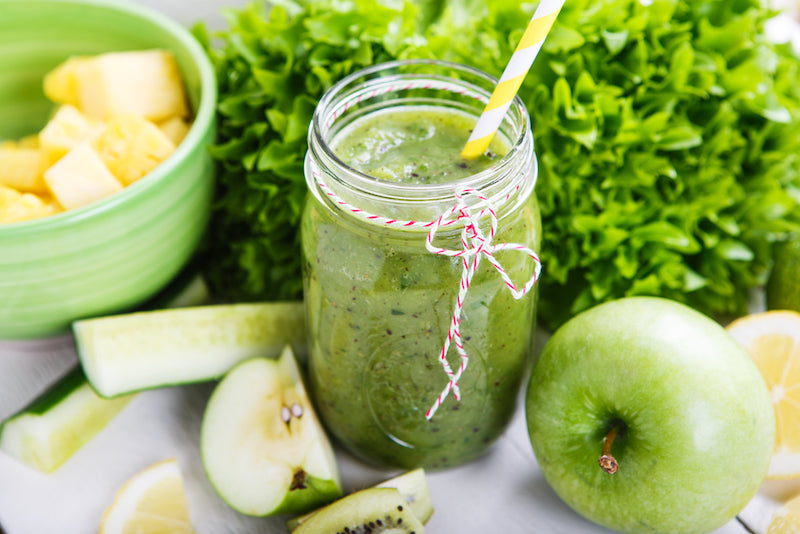If you’re looking for a filling, high-protein, fiber-rich breakfast option, we got you covered with this delicious apple avocado PB smoothie recipe.
Green Goddess Smoothie
Serves 1
Ingredients:
- ½ avocado
- 1 small green apple
- 1 large handful of spinach
- 4-ounces of plain greek yogurt
- 1 tsp of honey
- ½-1 cup of reduced fat milk (or milk of choice)
- 1 scoop organic peanut butter powder
- ½ to 1 cup of ice
- Optional: 1 tsp of chia or flaxseeds
Directions:
- Blend ingredients together in a high powered blender until smooth.
- Add more ice or water to achieve desired consistency.
Nutrition
- Calories: 433
- Fat: 15g
- Total Carbohydrates: 50g
- Fiber: 12g
- Protein: 27g

Why is Protein Vital for Breakfast?
Protein is one of the most satiating macronutrients. Starting your day with a hearty dose of protein can set you up to meet your protein needs with ease throughout the day, an important thing to consider for those who are very active, as well as quell any possible desire to snack between meals.
In fact, many research studies have found that consuming a protein-rich breakfast can help you eat less throughout the day. Aim to choose a breakfast that contains at least 20 grams of high-quality protein from sources such as meat, fish, poultry, dairy, or eggs [1, 2, 3].
How Much Protein Can I Absorb at Once?
While protein is important, you can consume too much. Experts believe your body can only absorb a certain amount of protein at one sitting.
According to research, it’s estimated that the body best utilizes between 20-25 grams of protein within a 1-2 hour period. Anything beyond that may be used for extra energy or stored as fat.
For those who are trying to build muscle mass, research suggests there may be a limited amount that can be utilized during muscle protein synthesis. Therefore, consuming very large doses of protein post-workout may not be giving you the results you’re looking for [4].
Instead, experts recommend spreading out protein intake throughout the day to optimize protein absorption. It’s also a lot easier on your digestion compared to consuming a large dose of protein in one sitting.

Protein, Satiety, and Weight Management
Because protein promotes satiety, a high-protein diet is often recommended for those looking to lose weight.
Your body uses more energy to break down protein during digestion compared to other macronutrients. It also keeps you feeling full for longer by enhancing satiety hormones, which can reduce the incidences of overeating throughout the day [5].
While the current recommendation for protein intake for the average healthy adult is 10-35% of their total calories, one study found that adults who increased their protein to 25% of their total calories experienced significantly reduced late night snacking and obsessive thoughts about food by over 50% [6].
Protein is also believed to be essential for weight management after weight loss. In fact, many studies found that those who increased protein intake post-weight loss were less likely to gain the weight back compared to those who didn’t [7, 8, 9].
Why is Fiber Important for a Healthy Weight?

Fiber is another essential component in maintaining a healthy weight. Fibers are non-digestible carbohydrates that can act as bulking agents (soluble fiber) or increase transit time in the gut (insoluble fiber) depending on the type.
Some research has determined that soluble fiber may be particularly helpful in losing and maintaining a healthy weight. Soluble fiber can increase satiety by slowing digestion and gastric emptying, therefore reducing overall calorie intake throughout the day [10].
How Much Fiber Do I Need Daily?
It is recommended that adults consume between 25-38 grams of fiber per day. Ideally this will include a mixture of both soluble and insoluble fiber sources [11].
Be sure to spread your fiber intake out evenly throughout the day and avoid consuming it all in one go as this can result in gastrointestinal discomfort.
If you are looking for packaged items that are a good source of fiber, look for products that contain at least 5 grams per serving.
What Foods Are the Best Source of Fiber?

You can find rich sources of fiber in fruits, vegetables, whole grains, beans, legumes, nuts, and seeds.
Some good sources of soluble fiber include beans (such as black beans, kidney beans, and lima beans), brussel sprouts, avocados, sweet potatoes, broccoli, pears, apricots, apples, seeds (such as flax seeds and sunflower seeds), and oats.
Insoluble fibers can be found in whole grains, wheat bran, couscous, some beans and lentils, some nuts and seeds, root vegetables (such as carrots, potatoes, and parsnips), celery, and cucumbers.













